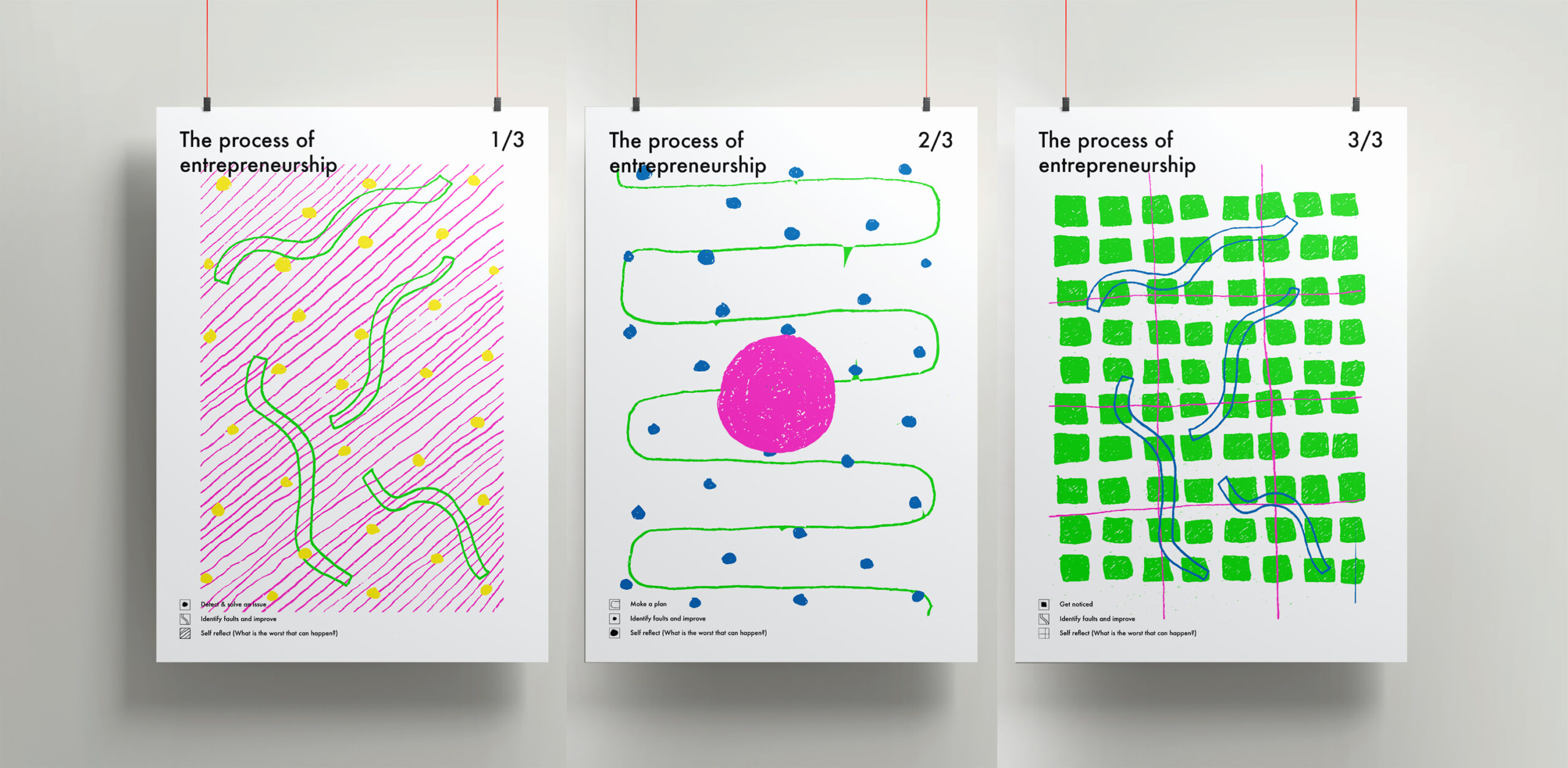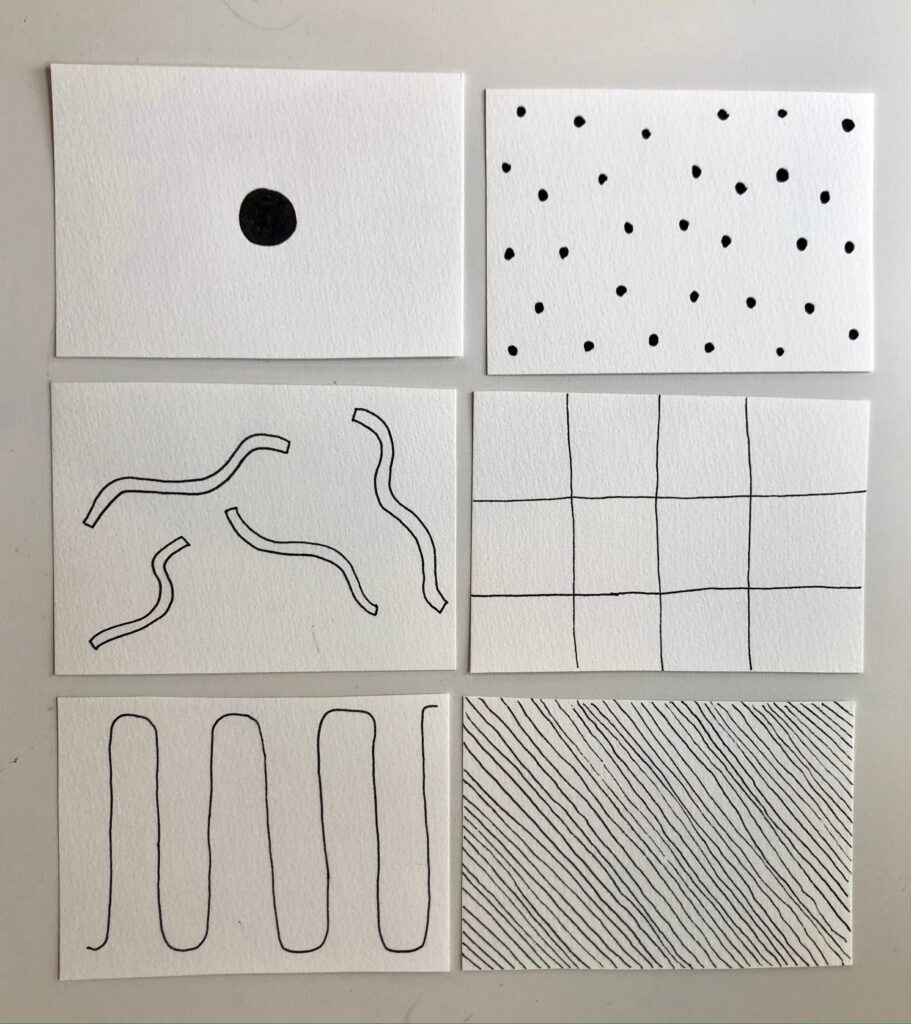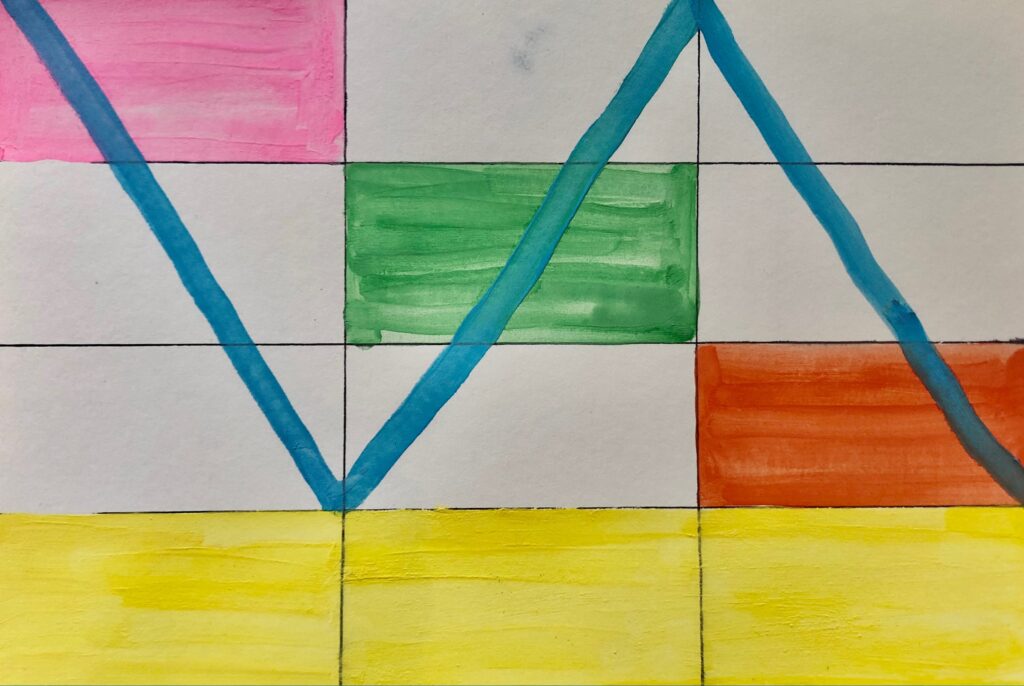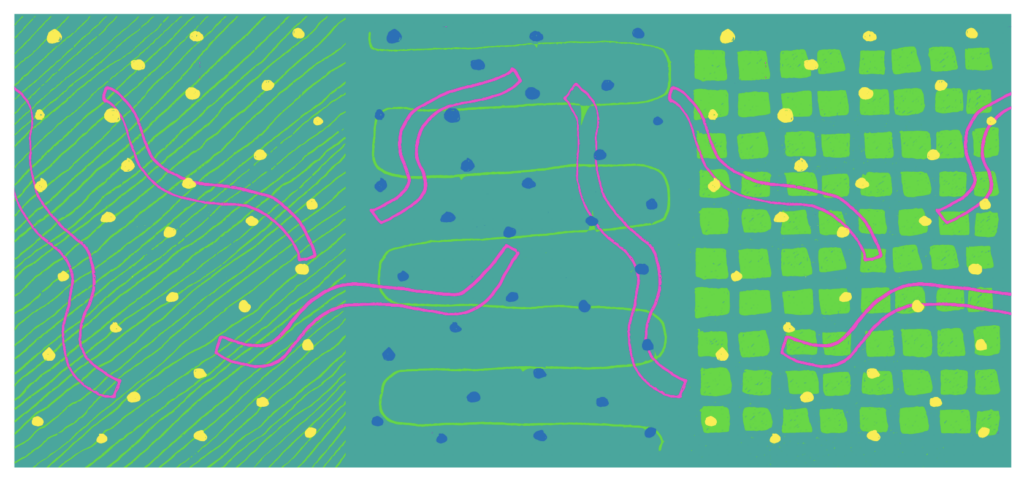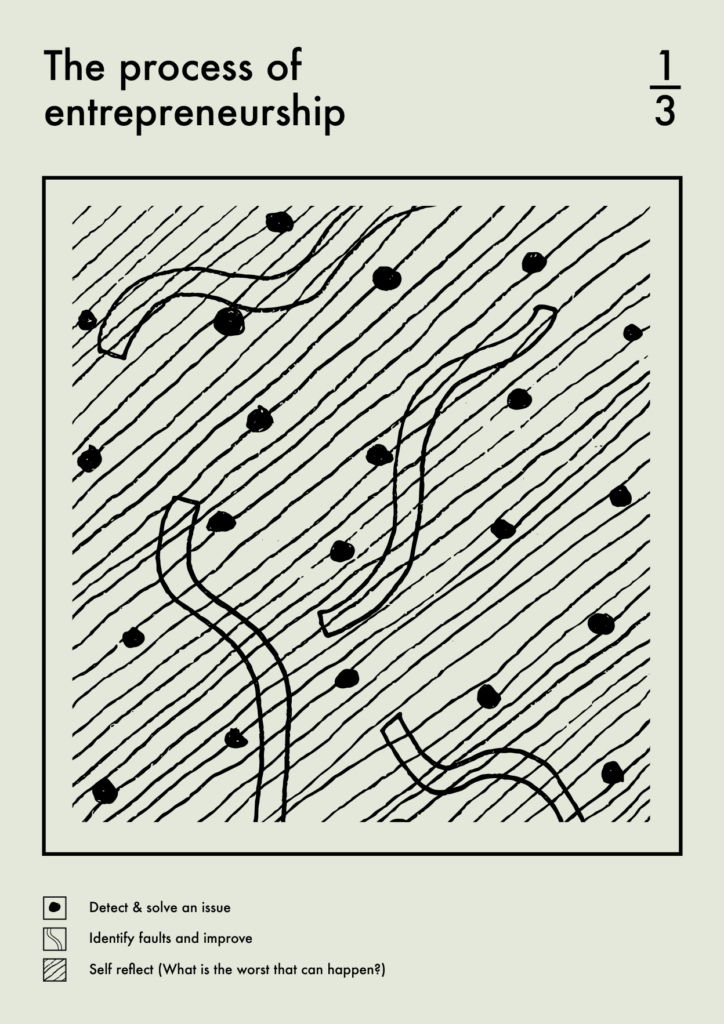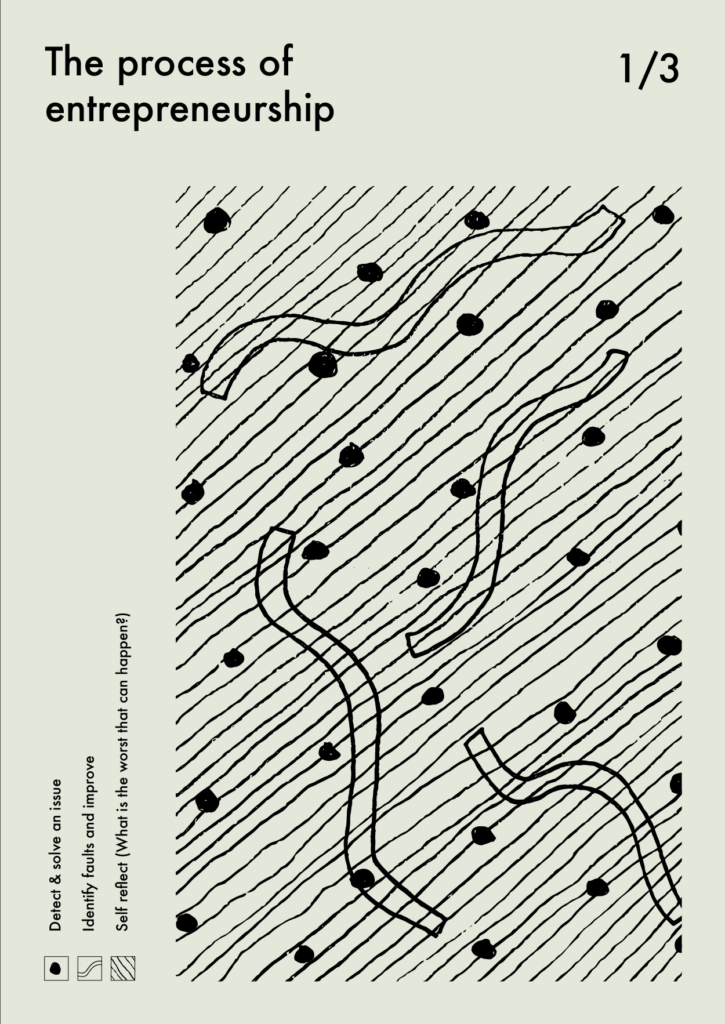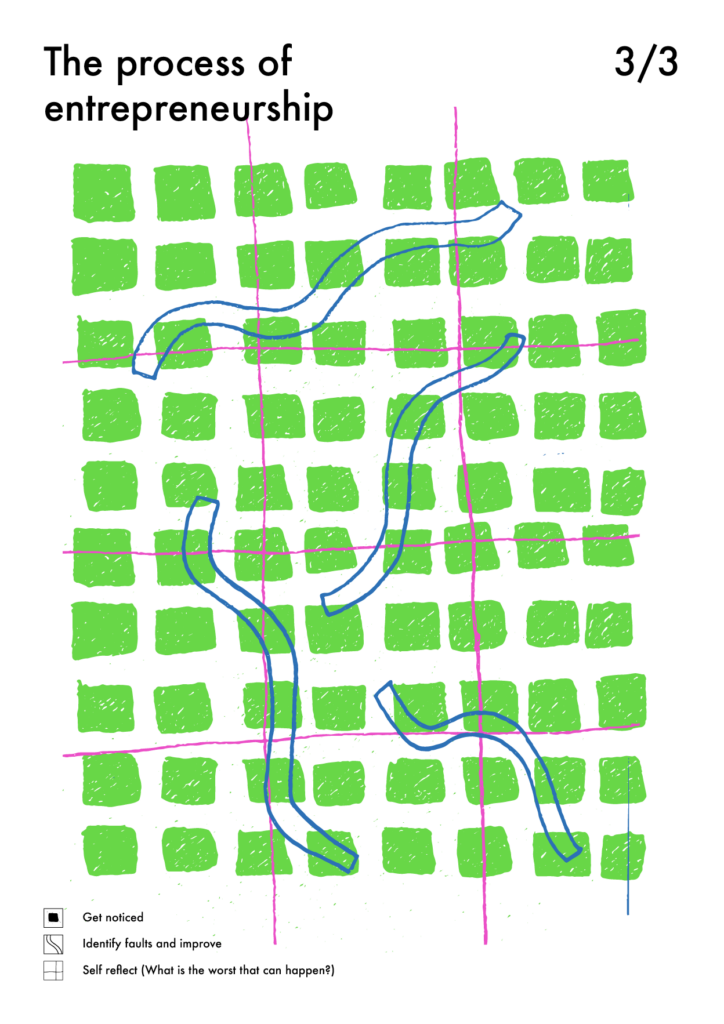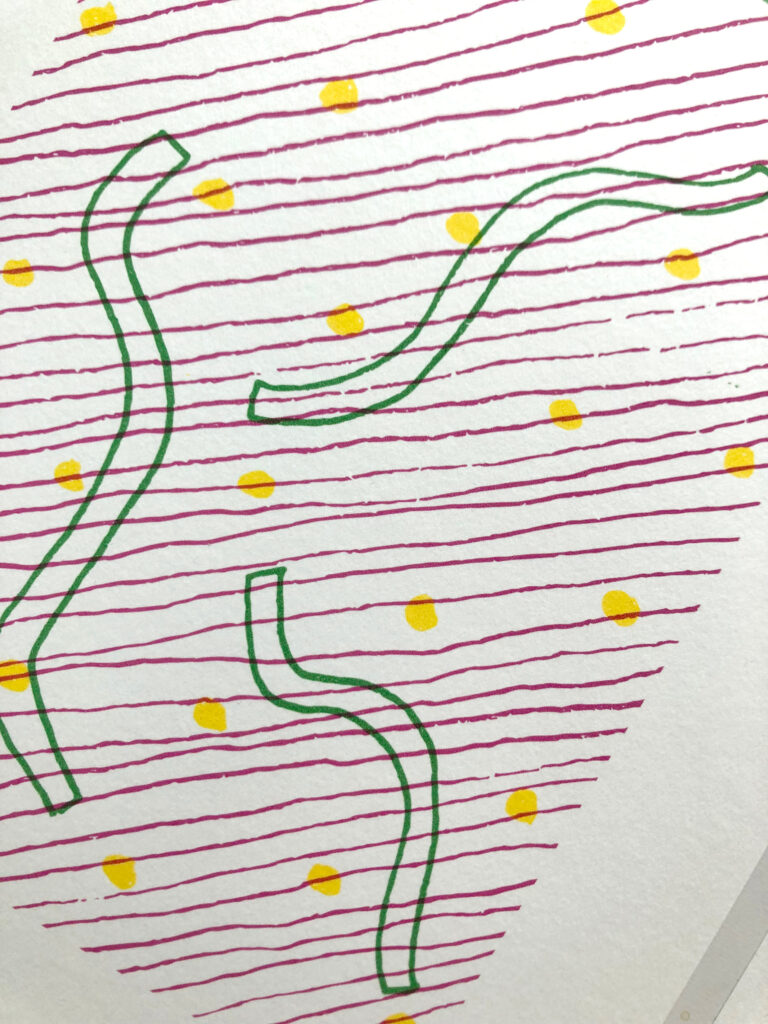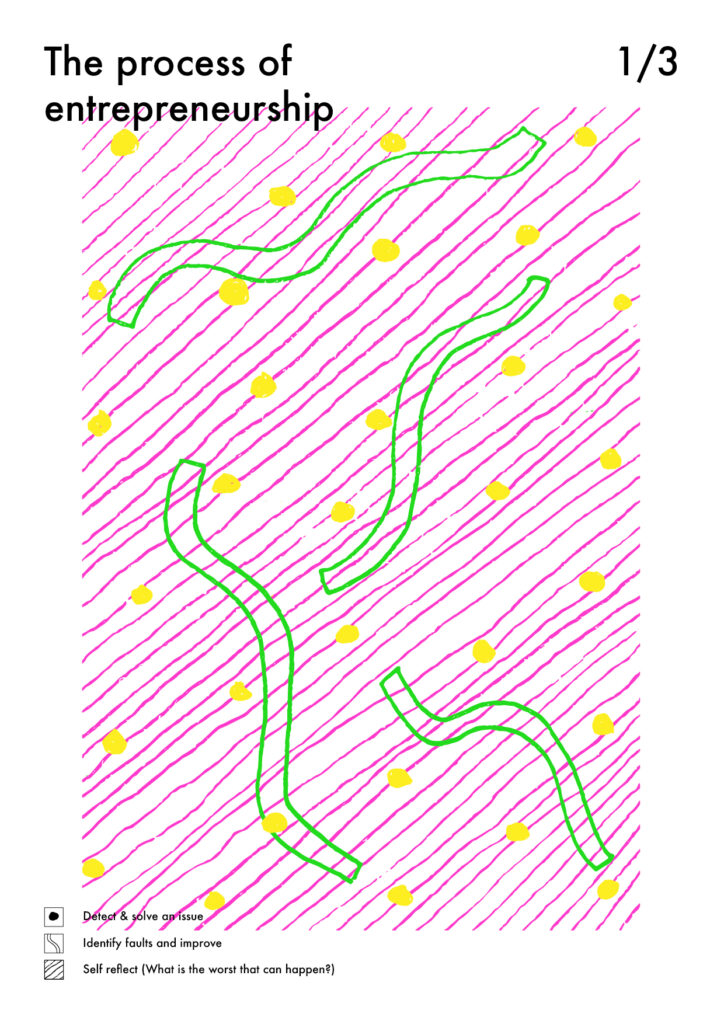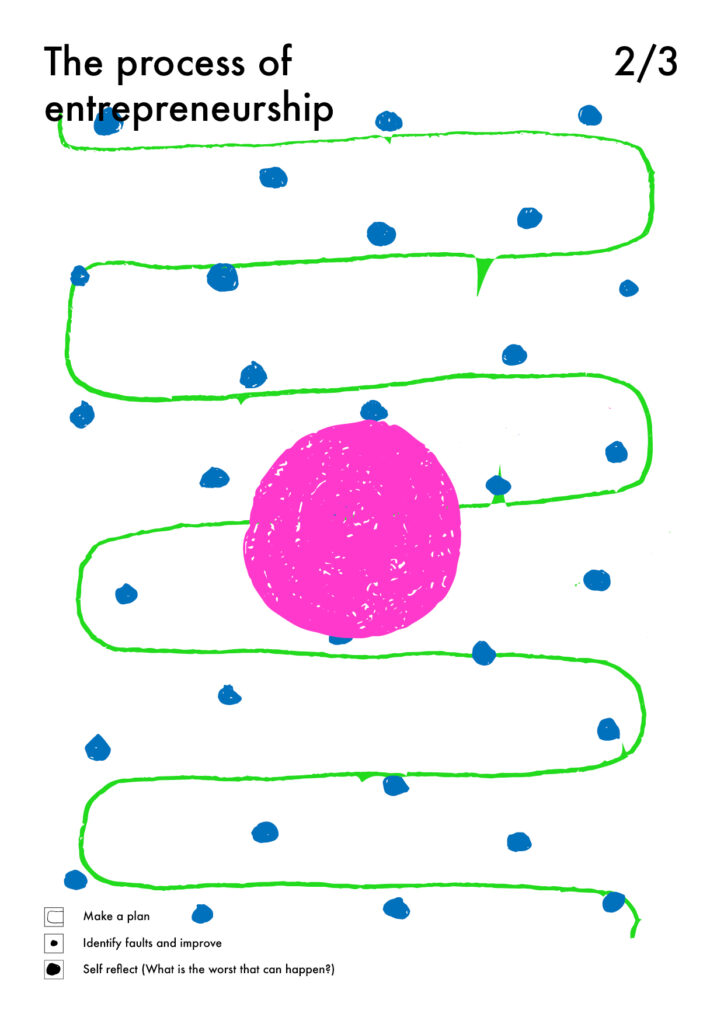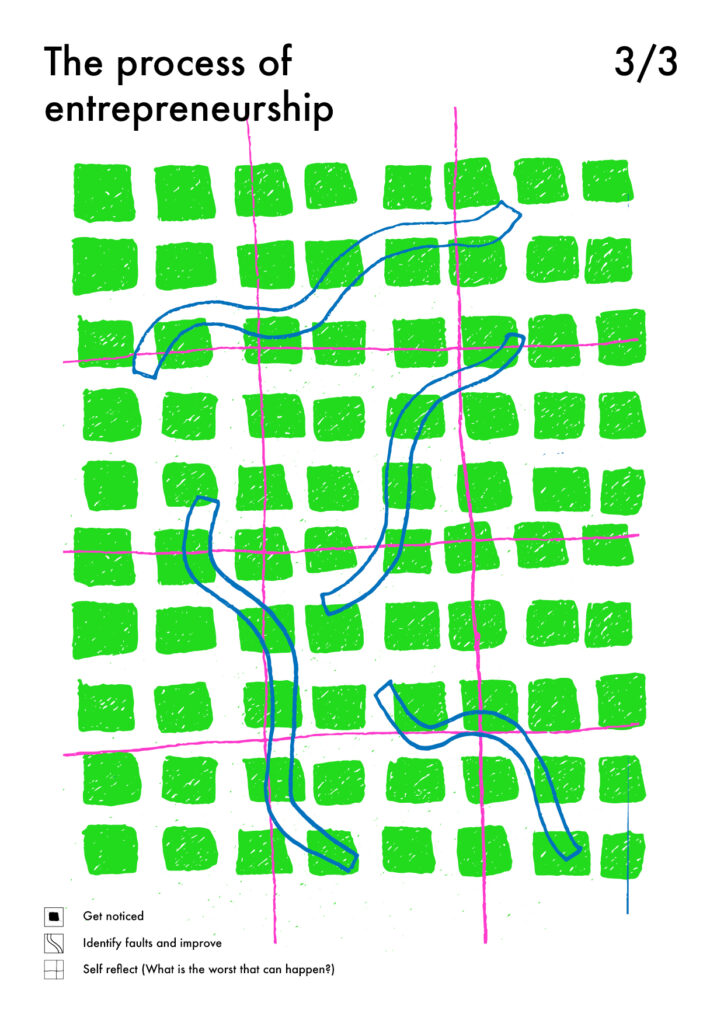Lecture notes
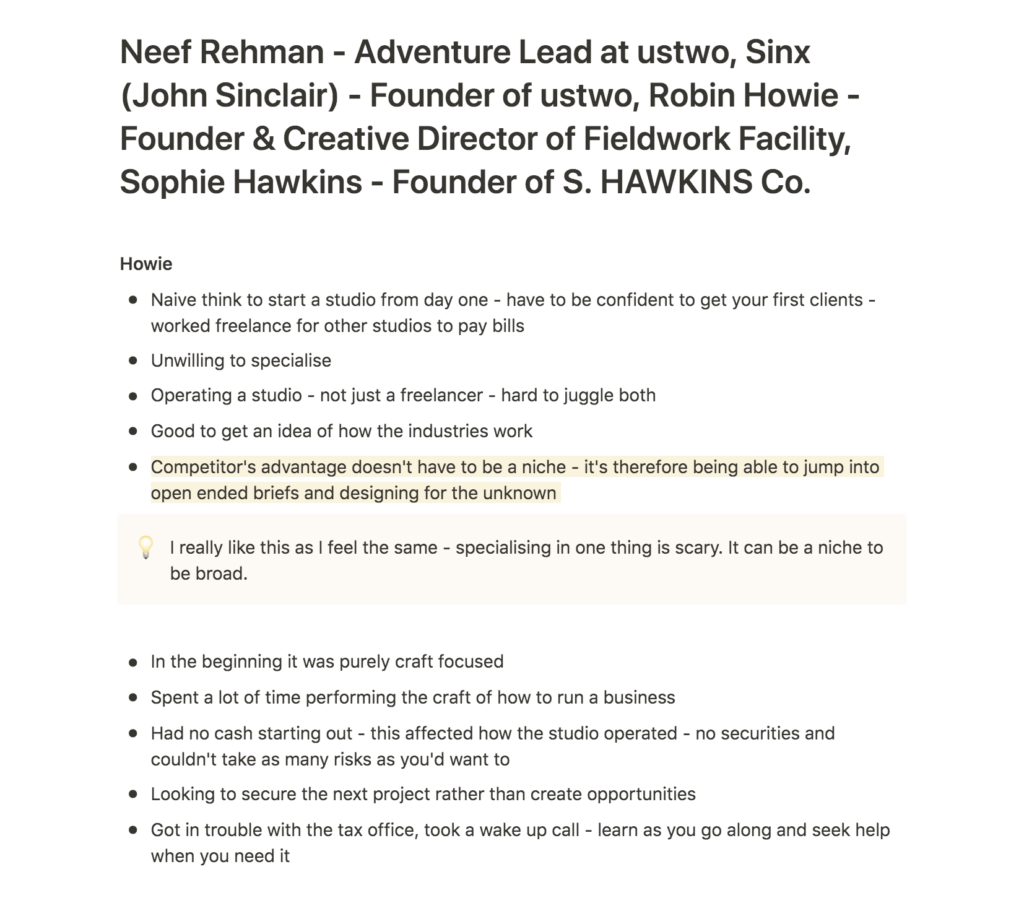
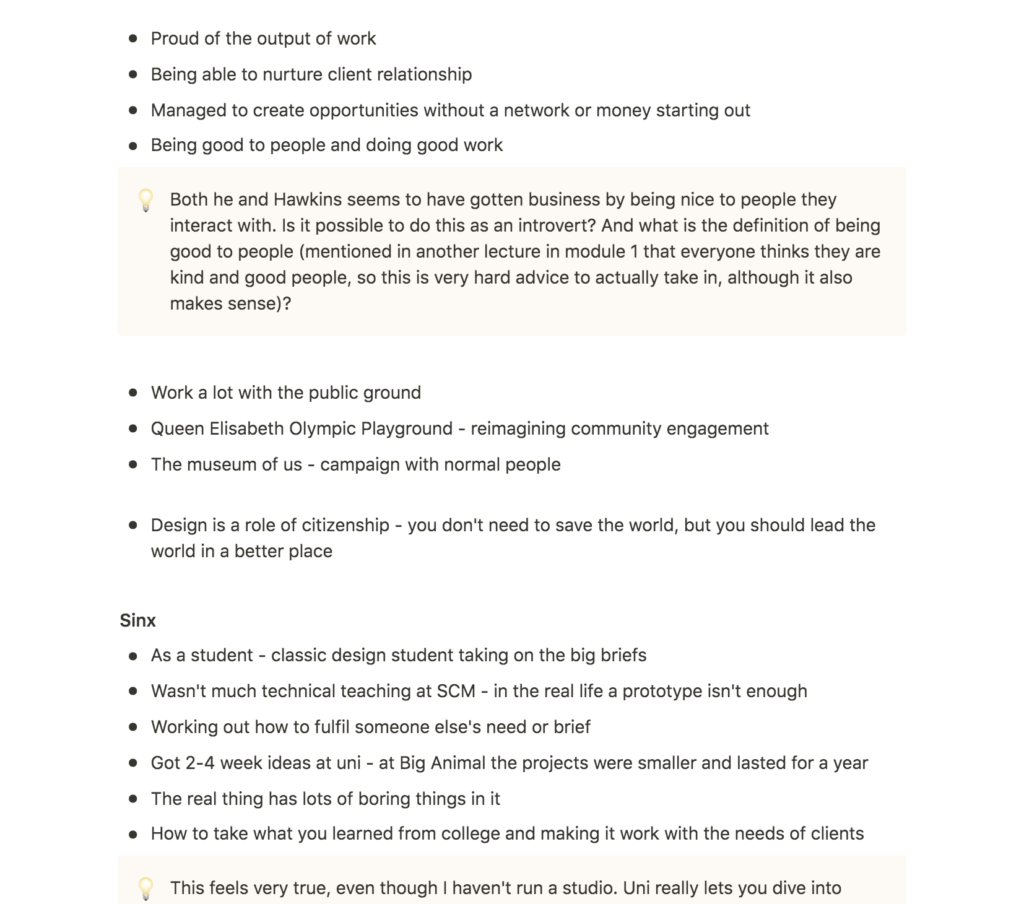
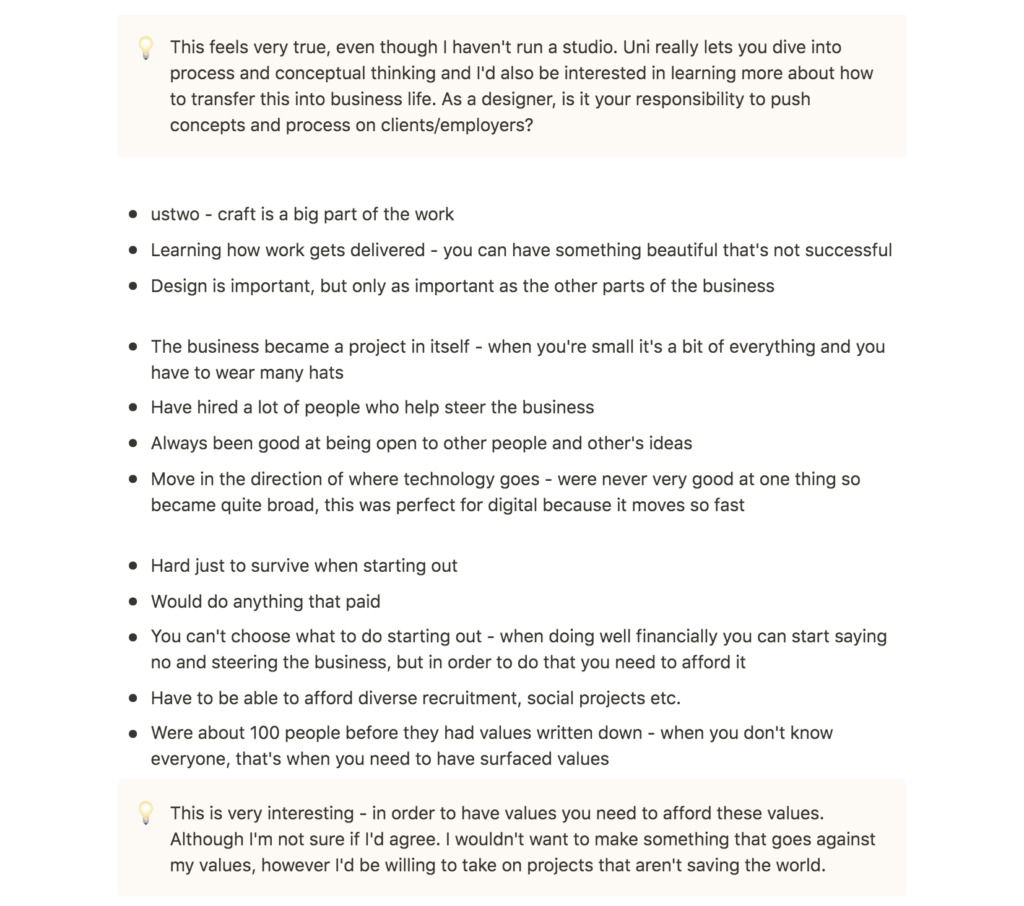

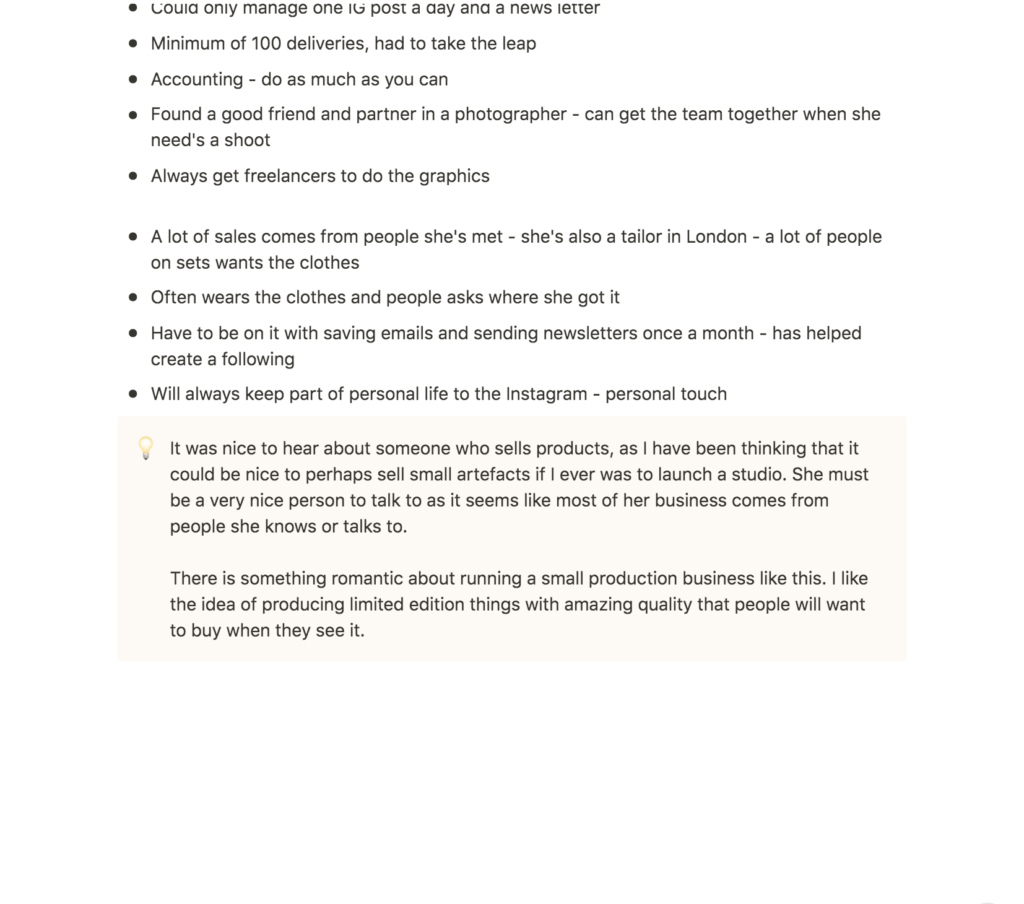
Lecture reflections
I was happy to hear Robin Howie’s thoughts on specialising and how he saw his competitor advantage as being able to do open ended briefs because his work is broad (Neef Rehman et al., 2021). Having to specialise is something I’ve looked at as important throughout this module as most case study participants have mentioned the importance of having a niche. As a creative I often find myself going on to try new things, and I don’t really like the idea of doing only one thing really well. Wearing more hats is very appealing to me, and I’d like to start thinking of this as an advantage in the same way as Howie.
Something I did find a little intimidating about the lecture was that most of the interviewees seemed to have gotten work from people they know. Although I’d like to think of myself as a kind person, I’m not the most outgoing and thus I worry about not being able to network well enough to become an entrepreneur (not saying I will have to become one, but I’d like to think of it as a possibility). Moving forward I’d be interested in looking further into stories on introverts who have made it as entrepreneurs.
Resource notes
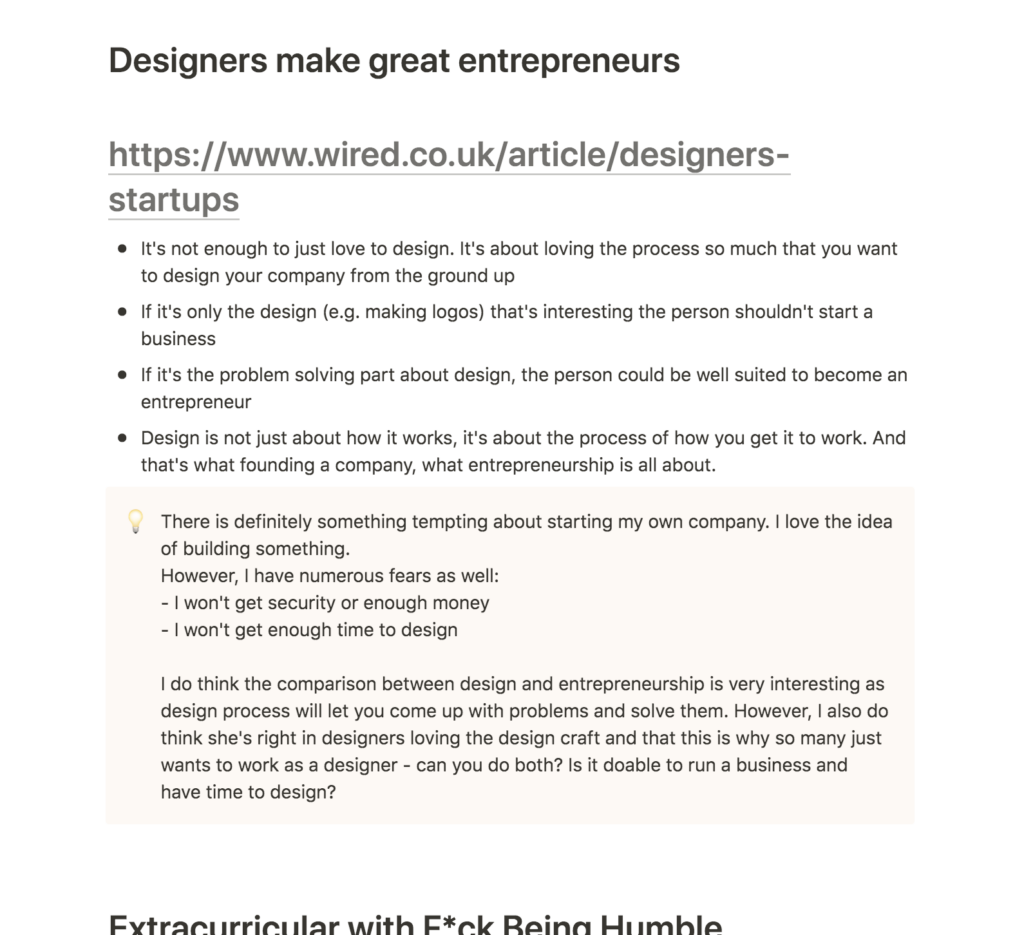
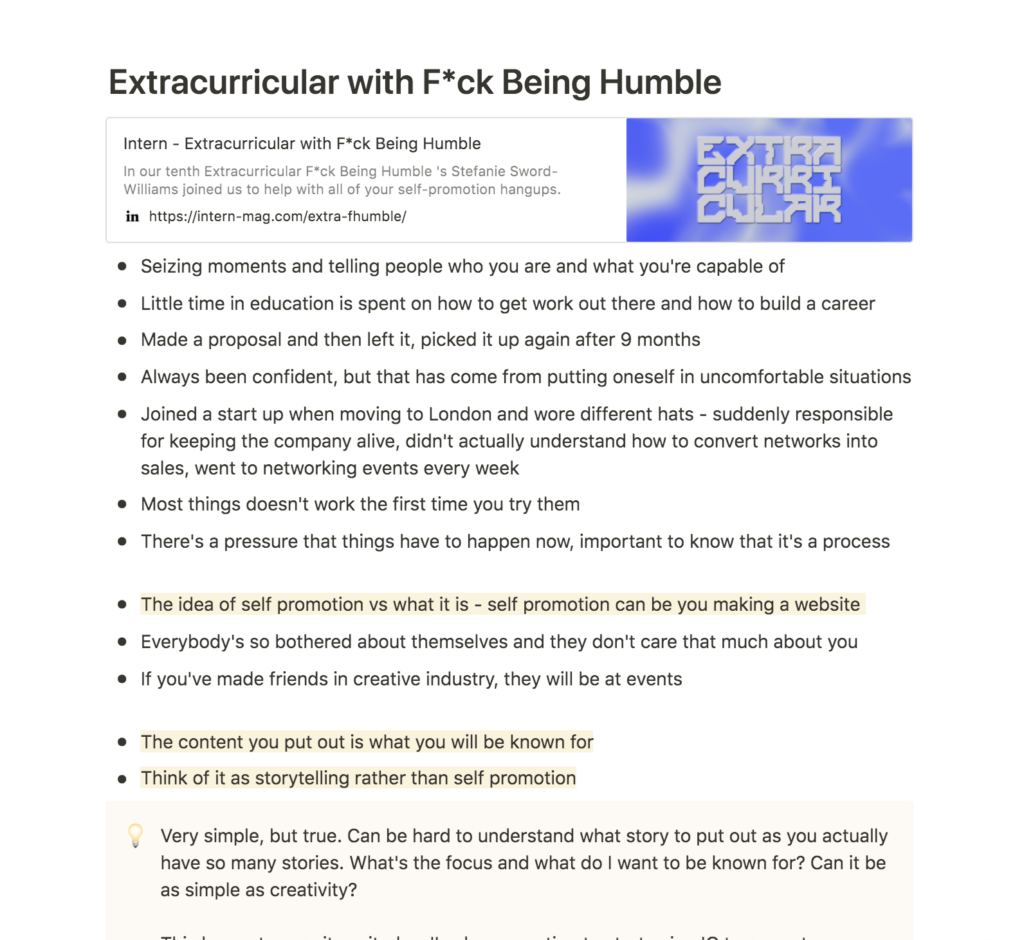
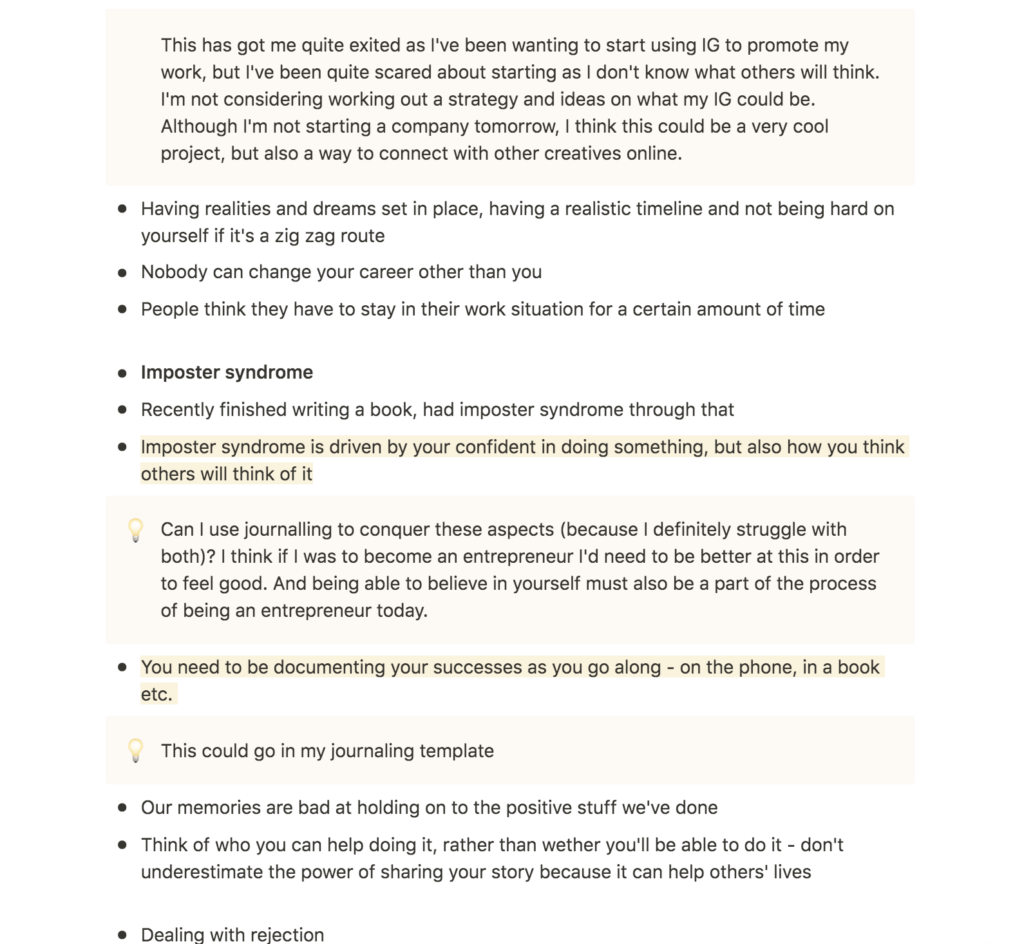
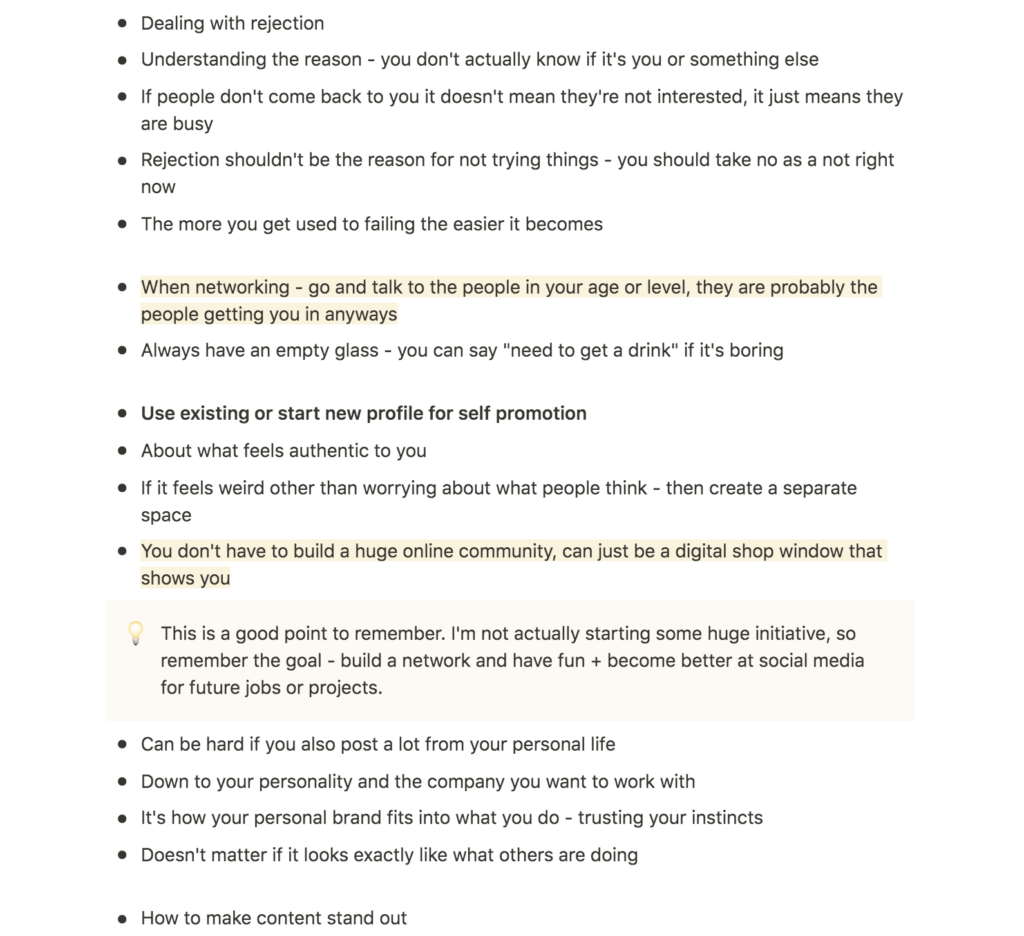
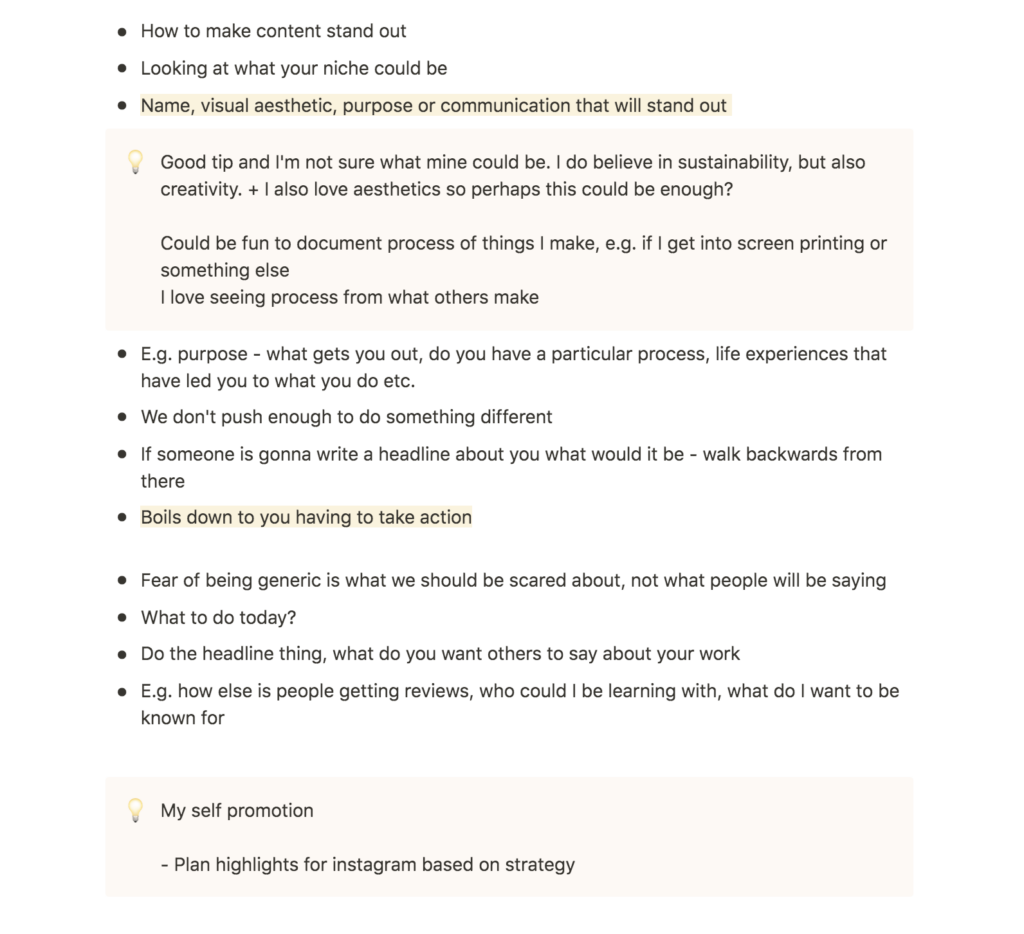
Resource reflections
Designers make great entrepreneurs, they just don’t know it yet
This article was very interesting and I think it makes a lot of sense that designers would make great entrepreneurs as creating a business can be done through the use of a design process (Jessica Alter, 2013). I think Alter’s point of one needing to want to build a company from the ground up, and not just wanting to make logos is important (Jessica Alter, 2013). Before starting a business, one should probably think this through, and as per myself I’m not quite sure where I stand. I love the idea of building something from the ground up, but I also love the craft of design.
Is it doable to run a business and also have time to explore your craft? To me it seems so, but perhaps only within a certain company scale. I don’t think I’d enjoy running a large design studio or other type of company where designing wasn’t still a part of my everyday work.
In terms of the workshop challenge I think it could be very interesting to look at the meaning of being a design entrepreneur in light of the design process, as this seems vital to the building of a business in terms of problem solving and development.
Jewel Purpose
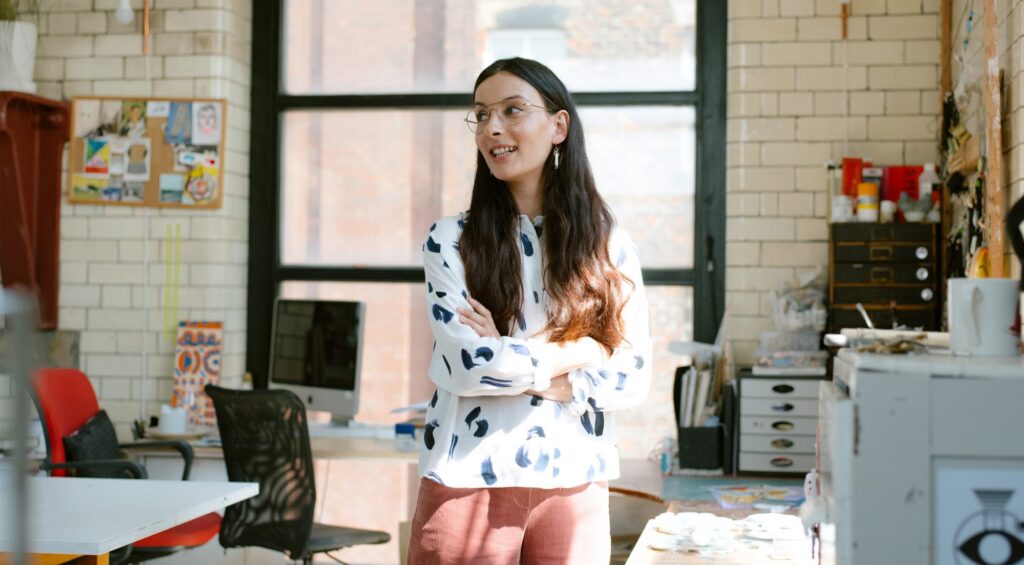
In regards to not specialising in my practice, this Intern Mag article was lovely to read. The article is about the multidisciplinary artist Aliyah Hussain who has a very varied practice (from jewellery to sound design) (Ava Macpherson, 2018). I think if I was to start a studio I would want to look into ways of adopting this fluid approach to craft.
Hussain is an interesting person to look at when discussing entrepreneurship, as her “entrepreneurship” is described as art, rather than a business. Before embarking on this module I thought of an entrepreneur as a person who creates new products that are usually backed by investors. Now however, I assume that entrepreneurship can be anything self initiated, even if it’s a side hustle or just a personal project (making a profit might still be central).
Three ideas for making extra income from your creative skills
Recently I’ve been tempted to perhaps start selling made to order prints or artefacts and I therefore enjoyed this article on ideas for making an extra income as a creative. I like the idea of starting a personal project whilst also making some money if possible, and if no one decides to buy then the making in itself will be worth the hassle. Making prints for example, could be a great way of learning more about printing techniques whilst also practicing my illustration or custom type skills. I’m not entirely set on going ahead with this, but I’m very much into the idea at this point in time and I’d love to look into it further.
As a design studio I also think it could be great to look at multiple ways of earning an income (as reflected on in prior weeks). My hypothetical studio could produce prints, but also courses, books or typefaces.
Extracurricular with F*ck Being Humble

Whilst looking through the Intern Mag website I discovered a great Extracurricular episode with F*uck Being Humble, where topics like self promotion and dealing with imposter syndrome were discussed (Intern Mag, 2020). I’ve been wanting to think of ways to include design on my Instagram lately, but I’ve definitely been scared about committing to it, but also about what people might think. This episode was therefore hugely helpful in terms of motivation.
The discussions on imposter syndrome also got me thinking about mental health and entrepreneurship. How important is confidence when starting your own business and how can we make sure to keep going after failure? As mentioned by Sword-Williams, it can be difficult to remember successes and her advice was to document them on your phone or in a book (Intern Mag, 2020). I might make myself a goal of doing this, as imposter syndrome is something I tend to have quite a lot and it can sometimes stop me from being productive or seeking out opportunities. In order to be happy as an entrepreneur I imagine that dealing with failure and being confident might become very important.
Further research
F*ck Being Humble x PUMA #SheMovesUs
Feeling inspired by F*ck Being Humble, I decided to watch another video by Sword-Williams where she talks about methods for dealing with fear and imposter syndrome. I particularly liked her advice on journalling as I have used this successfully in the past. As I could probably increase my self esteem quite a bit in terms of my work (especially if I am to start using my Instagram profile more consciously and perhaps start my own studio one day), I might adopt this as a weekly activity as a way of improving as a designer on a mental level. I think the idea of looking at mental health in light of entrepreneurship and it’s definitely something I’d like to learn more about.
Notamuse
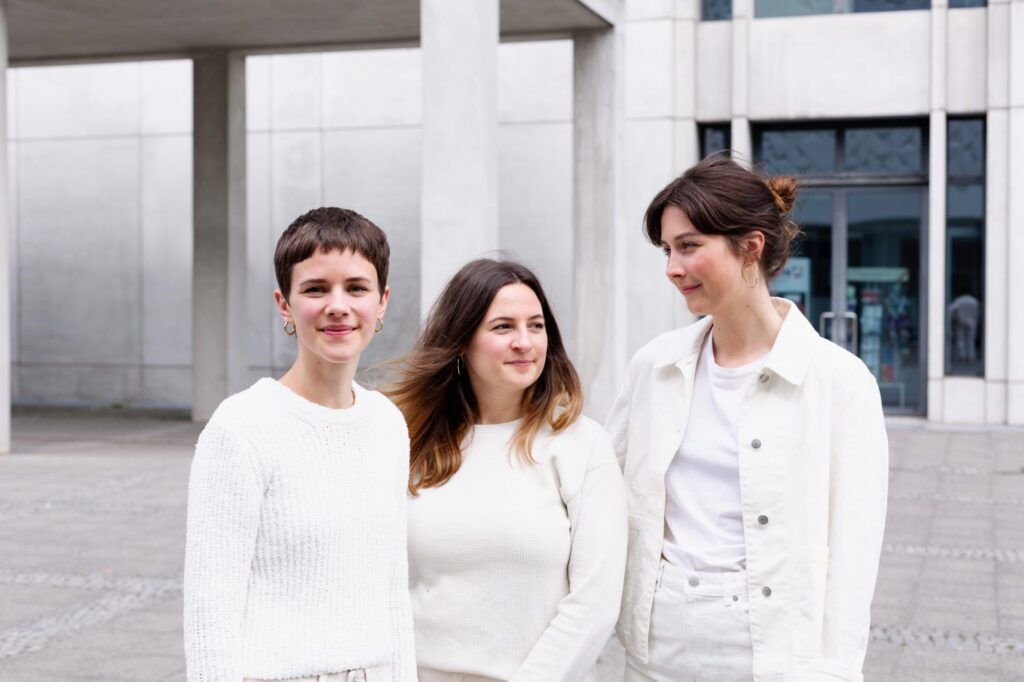
Through this week’s resources I discovered Notamuse, who’s aim is to showcase women designers. After looking at F*ck being humble, I was surprised to see that most women who was interviewed on their website mainly avoids self promotion (Notamuse, Ca. 2017-2018). The interviewees also discuss how there’s a lack of female role models in graphic design and the fact that history books rarely mentions women (Notamuse, Ca. 2017-2018).
Gender equality is a topic I care greatly about, and I think it could be interesting to angle my work towards women entrepreneurship this week. I wouldn’t want to force people to become entrepreneurs, but I’d be interested in creating an encouraging outcome that could help women build their courage (which is also very much in line with F*ck being humble).
What is design entrepreneurship?
In the Medium article by Robert Lzicar, What is design entrepreneurship?, Lzicar explores the definitions of design entrepreneurship. Lzicar explains this as stepping away from the economic rituals that comes with working for clients, and rather defining one’s own problems and creating solutions that become business ventures (Robert Lzicar, 2018). I think this is an interesting definition which made me realize that design entrepreneurship can be the making of products, rather than the notion of starting a design studio. Thus, as Paul also discussed on the ideas wall this week, design entrepreneurship can be about design authorship, which could be something as simple as creating a poster or zine.
In terms of process, I do wonder what actually separates the design process from an entrepreneurial process. Surely if you follow the double diamond when doing a self initiated project, this process could be seen as entrepreneurial?
Printed Goods
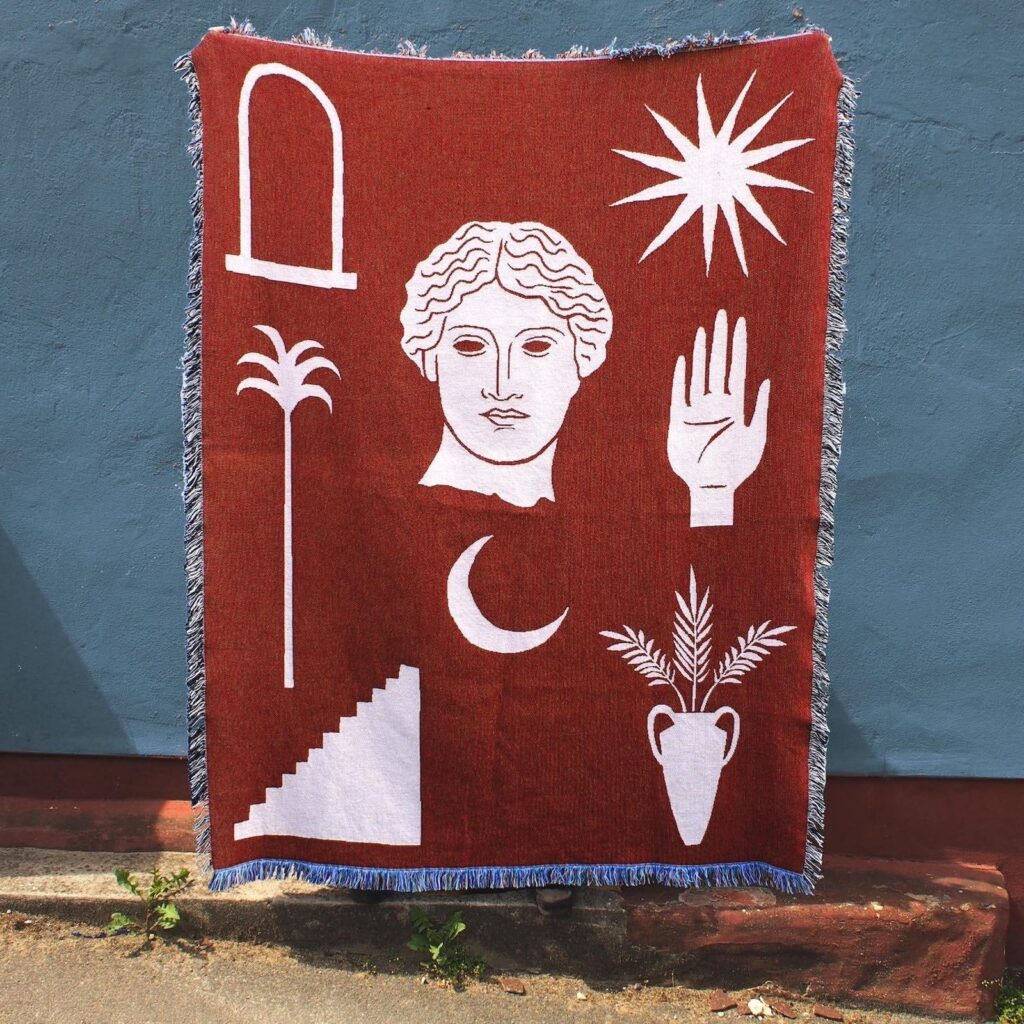
In relation to my previous point, this interview with Printed Goods is interesting as the duo says “Having a creative approach is not just about producing your work, but how you present and apply it” (Marianne Hanoun, 2019).
If we only look at the definition of design entrepreneurship, surely the amount of women would be relatively large. However, if we take into account that design entrepreneurship is also about presentation, the number might decrease if we were to assume that women generally don’t like to self promote (as suggested in interviews on Notamuse). The Printed Goods team also refers to self-doubt as one of their biggest challenges when starting their business (Marianne Hanoun, 2019). Staying confident and being mindful of your mental state might thus be an important part of the entrepreneurial process.
Further, I also think the duo’s points of staying patient, identifying what’s preventing you to achieve what you want, and identifying faults in order to improve, seem like good points for after the development of your product (Marianne Hanoun, 2019).
Workshop challenge
Having made the reflections above in my further research, I was interested in creating an infographic that would encourage entrepreneurship amongst those who hadn’t necessarily thought about this as an option for their career (e.g. women or people who first and foremost view themselves as artists, rather than business people). In this video by The Futur, Jose and Chris talks about their own message and how some people see them as dirty and sell outs (The Futur, 2014). I’d be interesting in creating something that could help remove the stigma around business and entrepreneurship by showing that this can also be connected to creative and perhaps personal projects.
&Walsh: Creating Self-Initiated Projects
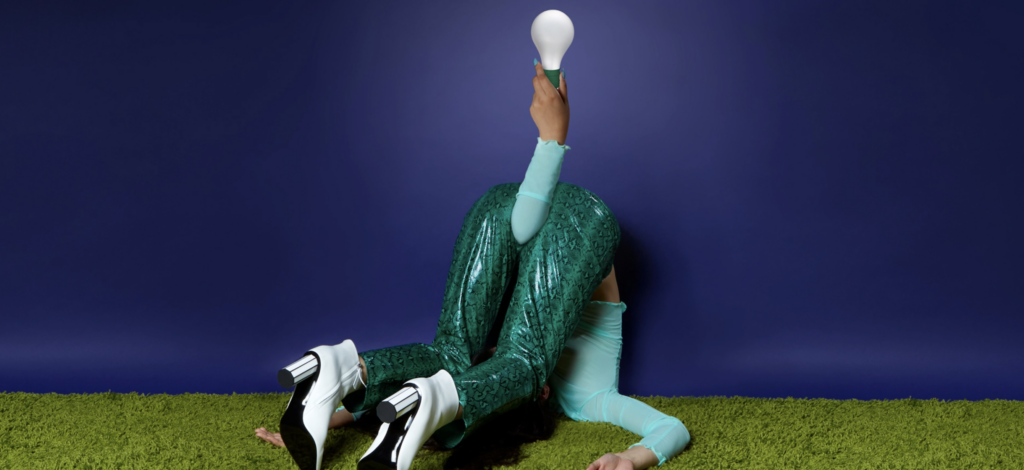
In order to combine the design process with other aspects of entrepreneurship, this article by &Walsh was great. In the article Walsh refers to self initiated projects as:
a great way to exercise your creativity, experiment with techniques & show the world what you’re capable of making. Sometimes, these ideas can turn into businesses. Even when the goal isn’t profit, these types of projects can often lead to people discovering your creative work & getting more work in the future.
(&Walsh, 2019)
I think this way of looking at entrepreneurship is great, as it’s less business sounding, and perhaps therefore less intimidating. I also like the idea of entrepreneurship being an idea/passion first, and a business second, because we as creatives might more often than not be motivated by craft rather than money.
Walsh’s guide consists of 6 steps:
- Detecting issues or annoyances
- Finding potential solutions (and choosing one of them to focus on)
- Creating a plan
- Make a set of rules (e.g. what and how often you will do something)
- Develop a unique style (branding)
- Getting the project noticed (e.g. through social media)
(&Walsh, 2019)
When conveying the process of design entrepreneurship I think I’d like to follow the design process as Walsh has done, and then move on to ways of actually launching and running the project (which seems to be the hardest thing for people who might be struggling with fear or low confidence).
Analysis: What’s stopping me from self promoting and launching products?
As mentioned previously, I have thought a lot about getting into self promotion on Instagram, and perhaps start selling self made products like prints or t-shirts. Since I have been toying around with this slightly entrepreneurial idea, I thought it could be nice to self reflect on any issues I’m having in regards to going ahead with this. By doing so, I could potentially detect issues others might be having as well.
Worries in regards to self promotion and selling prints online:
- I worry about what other people might think (full of herself, she thinks she’s good and she’s not, it’s lame, it’s cringy, etc.)
- I worry that it will take up too much time
- I worry about failing and everyone knowing it
- I worry about it not turning out the way I want it to (similar to failing, but on a personal level)
- I worry about financial aspects (more in regards to starting a full time business, like a design studio)
- I worry about not being able to commit once the product is out there
Looking at these issues I realized that none were in regards to the process of creating a product, but rather what other people will think, of failing, of not being good enough and of lack of commitment. All of these issues stems back to mentality and confidence.
By writing down my worst fears, I was actually able to detect that all of my reasons for not going ahead with my idea were bad reasons. Thus, I got the idea of making “what’s the worst that can happen?” a part of the design entrepreneurial process (also mentioned in The Futur video mentioned previously).
Coming up with a process
Based on my research, I went on to develop a design entrepreneurial process. Inspired by F*ck Being Humble and Notamuse I was interested in creating an infographic which would inspire those who might be scared to launch a personal project or business. Based on my readings and personal analysis I discovered that the main obstacle in going ahead with this could be lack in confidence or fear that it won’t work out. I therefore decided to make the more pragmatic steps of the process (like developing the product and branding) to the point, so that self reflection and improvement would shine through.
Based on &Walsh’s guide to self initiated projects, and the interview with Printed Goods, I established the following steps:
- Detect & solve an issue
- Make a plan
- Get noticed
- Self reflect
- Identify faults and improve
The last two steps should really be done continuously throughout the process, and I was therefore interested in experimenting with overlaps in my visual.
Visual development
I really wanted my visual to appeal to designers who might not feel completely at home in the business notion of entrepreneurship. I personally wouldn’t even think about self initiated projects as acts of entrepreneurship, but in reality that’s exactly what they are, especially if they eventually turn into businesses. By focusing on play in creating something organic, I hoped to remove the business feel of the process.
Since I wanted my piece to be empowering to those who might feel worried or scared about launching a project/business, I decided that I wanted to play with a more fun aesthetic.
Tobias Gutmann
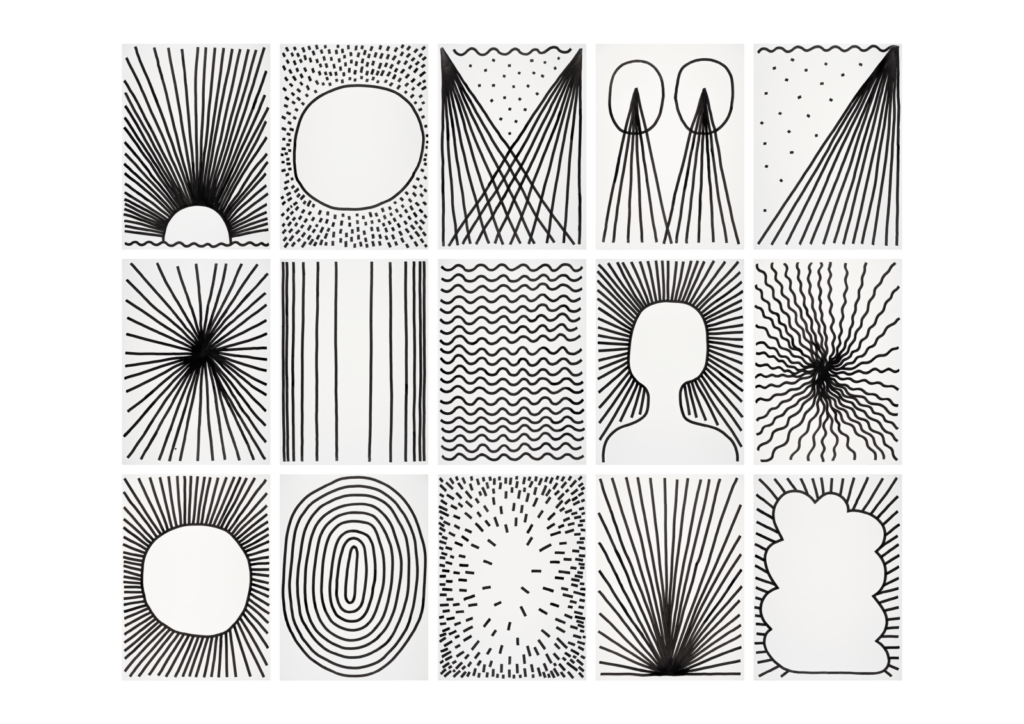
Tobias Gutmann is a great illustrator who’s work is very much shape and line based. When looking at the illustrations above I feel happy and they remind me of more refined children’s drawings. This was of great inspiration as I really wanted to appeal to the fun and artistry of designers’ practice.
Animal. Vegetable. Mineral.

This infographic by Louis Agassiz, portrayed in The Welcome Collection’s Animal. Vegetable. Mineral. inspired me to experiment with overlapping of colours and textures to illustrate a process. I think there is something lovely about old infographics, mainly because they are handmade which gives them a beautiful sense of imperfection. Again, as I wanted to appeal to the artistry of design in order to remind viewers that design craft can be entrepreneurship, I was inspired to embrace this sense of tactility.
Experimentation
I started my visual explorations with a quick texture study (below). Although I didn’t end up using these, I liked the idea of assigning one texture to each step of my process and creating overlapping patterns from them.
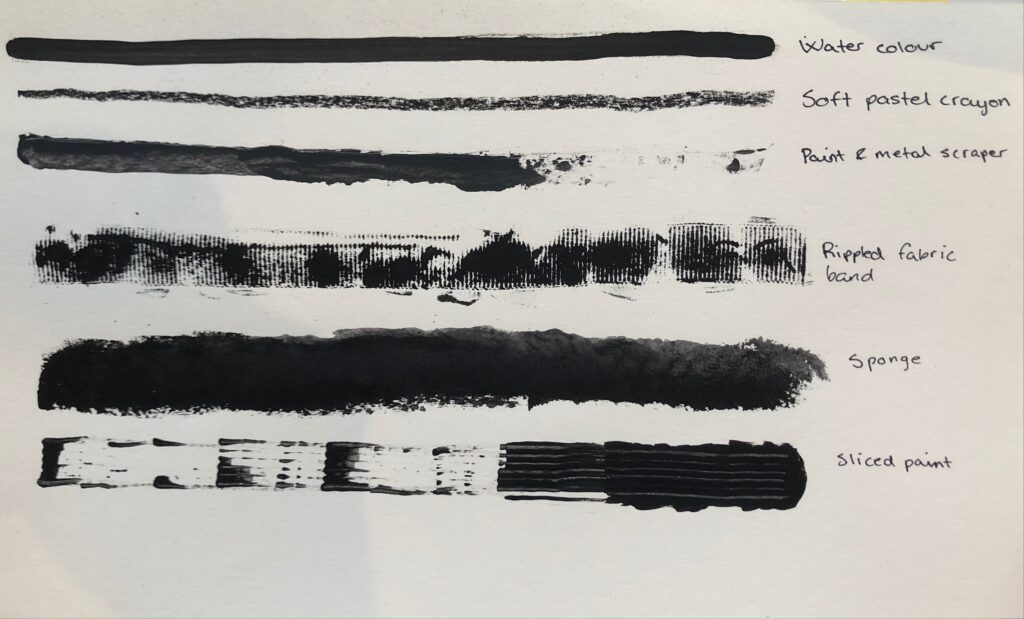
Further I went on to experiment with shapes and textures combined and separately. My idea was still to assign one texture/shape to each stage of my process. By doing so I wanted to communicate that self reflection and improvement should be part of every stage throughout the process.
I quite liked some of the individual shapes and decided to bring them into illustrator so that I could experiment with overlapping them there.
I found that overlapping more than three shapes looked a bit too busy, which is why I decided to create three sets of illustrations (one for each step of my process). I started off by using bright colours as I thought it could be cool to create something that could have been Riso printed (had I had the time and resources). This would refer to the more underground and ziney aspect of self initiated design projects, and thus be another reminder of entrepreneurship not needing to be very businessy.
If this was a longer project I also could have asked other design entrepreneurs to create their own shapes which I would overlap. This would represent a role models and be a reminder of how it is possible to succeed as an entrepreneur.
Even though I wasn’t able to riso print my designs, I tested the designs by printing one colour at the time using my home printer. Although it was difficult to get a nice photograph, the overlay created the effect I was hoping for. I therefore decided to stick with the coloured illustrations as these show an overlay better than if all shapes were black.
Final result
To me, the biggest con of starting a self initiated project is the idea of what other people will think. In most cases, being a design entrepreneur won’t mean loosing a lot of money since you will usually only need your computer and software (this is of course not counting the income you might loose if you quit your job). Since what people think doesn’t actually matter, my posters are designed to inspire those with an entrepreneurial spirit or idea to launch. Being designers, we are all familiar with the process of detecting an issue and designing a solution, so to me, building confidence, improvement, planning and self promotion are the most important factors of a design entrepreneurial process.
In order to visualise this I have created three infographic posters which comments on the importance of self reflection and self improvement by overlaying these steps on top of the three more pragmatic stages. I initially wanted to inspire women who sometimes struggle with self promotion, but I didn’t want to mention women in my posters specifically as lack of confidence can be an issue for anyone.
I have attempted to use a fun and craft based aesthetic. To me, design entrepreneurship is not simply about innovation or starting a business, it’s about self initiated projects and ideas that one chooses to explore because it’s providing value that isn’t necessarily economic. Thus, the definition of being a design entrepreneur today has been visualised by using an experimental and joyful visual language. As Walsh mentions in her article, self initiated projects are great for experimenting and showing what you’re capable of, and sometimes these projects can turn into businesses (&Walsh, 2019).
The digitalisation of my illustrations are not perfect and if I had more time I would have fixed this. I also would have liked to experiment further with more patterns and colours, and perhaps to work further on printing.
I don’t think my layout is very exciting so it also would have been good to work further on that. The joyful notion of my designs would also have been cool to use for animations and if the project was longer I might have attempted this as well. At the moment the posters are three separate units and through animations I might have been able to unify them somehow.
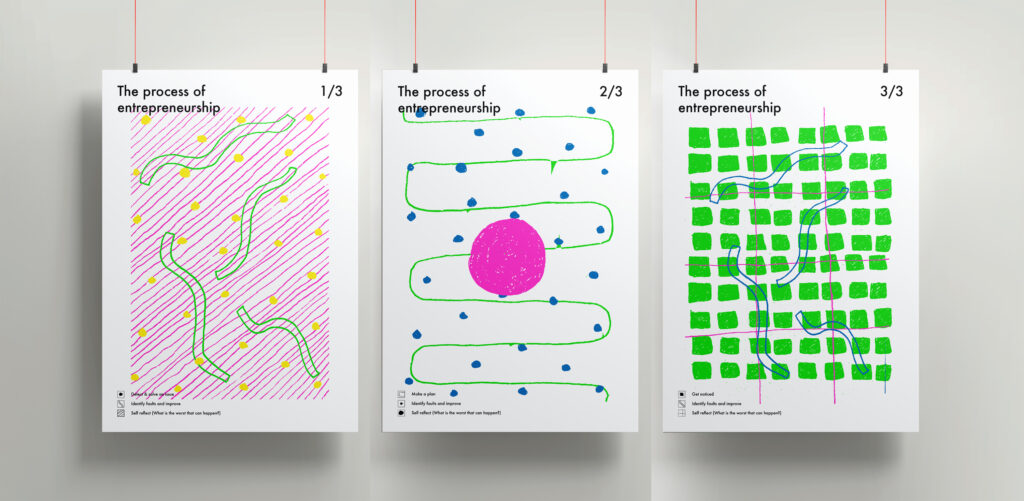
In conclusion
This week has been a little strange as it took me a while to understand what design entrepreneurship is. At first, my interpretation of this concept was the start of a design studio or the act of working for yourself. However, through my research I discovered that it’s more about self-initiated projects and ideas that may create value on another level than that of the economic.
The idea of focusing on positivity and encouragement in my work has been rewarding as it’s also given me some encouragement personally. Creating a variety of hand made diagrams almost became a meditative activity, and in my spare time the readings have inspired me to pursue journalling as a self reflection tool. I think my final result conveys the positivity I have attempted to adopt personally this week, but I worry that the infographics might be too ambiguous for others to understand.
In terms of process, this week has been a messy one. I haven’t been able to come up with a refined and complete idea I think, and if I had more time I would have liked to make the communication of each step slightly clearer. Although I like the colours and shapes, the quality of the illustrations and layout could have been improved, perhaps by scanning the illustrations properly so that they wouldn’t look as digitalised as they do currently. I also would have liked to work further with typography in order to convey my concept to a larger extent.
Although I spent a lot of time researching this week (which gave me less time to produce a visual outcome), I think it was essential to do so for my understanding of the next weeks’ topic. I’m left feeling inspired and excited to explore ideas for what ideas and projects I could potentially create in the future.
RESOURCES:
Ava Macpherson (2018) ‘Jewel Purpose’, Intern Mag, 12 July. Available at: https://intern-mag.com/jewel-purpose/ (Accessed: 25 July 2021).
Intern Mag (2020) ‘Extracurricular with F*ck Being Humble’. (Extracurricular). Available at: https://intern-mag.com/extra-fhumble/ (Accessed: 25 July 2021).
Jessica Alter (2013) ‘Designers make great entrepreneurs, they just don’t know it yet’, Wired, 16 August. Available at: https://www.wired.co.uk/article/designers-startups (Accessed: 25 July 2021).
Marianne Hanoun (2019) ‘“Have patience. There are no shortcuts to building your career”: Twins and business partners, Printed Goods’, Creative Lives – In progress, 25 February. Available at: https://www.creativelivesinprogress.com/article/printed-goods (Accessed: 28 July 2021).
Neef Rehman et al. (2021) ‘Lecture Week 9’. Canvas Falmouth Flexible [online], 23 July.
Notamuse (2017) ‘Notamuse’, Notamuse. Available at: notamuse.de (Accessed: 28 July 2021).
Robert Lzicar (2018) ‘What is design entrepreneurship?’, Medium, 8 March. Available at: https://medium.com/ma-communication-design/what-is-design-entrepreneurship-7d3f08ea33eb.
Stefanie Sword-Williams (2021) F*ck Being Humble x PUMA #SheMovesUs. Available at: https://vimeo.com/555359330/3ec0f18426 (Accessed: 25 July 2021).
The Futur (2014) The Designer As Entrepreneur. Available at: https://www.youtube.com/watch?v=nFm3uzNYQyU&ab_channel=TheFutur (Accessed: 28 July 2021).
&Walsh (2019) ‘Creating Self Initiated Projects’, &Walsh, 15 July. Available at: andwalsh.com/articles/all/creating-self-initiated-projects/ (Accessed: 28 July 2021).
LIST OF FIGURES:
Figure 1. Lauren MACCABEE. 2018. Jewel Purpose. Intern Mag [online]. Available at: https://intern-mag.com/jewel-purpose/
Figure 2. INTERN MAG. 2020. Extracurricular. Intern Mag [online]. Available at: https://intern-mag.com/extra-fhumble/
Figure 3. Mina AICHHORN. 2019. Makers, not Muses. Intern Mag [online]. Available at: https://intern-mag.com/makers-not-muses/
Figure 4. PRINTED GOODS. Ca. 2018-2019. Illustrated rug. Creative Lives in Progress [online]. Available at: https://www.creativelivesinprogress.com/article/printed-goods
Figure 5. &WALSH. 2019. Creating Self-Initiated Projects. &Walsh [online]. Available at: https://andwalsh.com/articles/all/creating-self-initiated-projects/
Figure 6. Tobias GUTMANN. 2021. Let There Be. Tobias Gutmann [online]. Available at: https://tobiasgutmann.com/
Figure 7. Louis AGASSIZ. 1848. Crust of the Earth as related to Zoology. It’s Nice That [online]. Available at: https://www.itsnicethat.com/articles/animal-vegetable-mineral-wellcome-collection-making-nature-281016
Figure 8: Ingrid REIGSTAD. 2008. Texture studies. Private collection: Ingrid Reigstad.
Figure 9-11: Ingrid REIGSTAD. 2021. The process of design entrepreneurship explorations. Private collection: Ingrid Reigstad.
Figure 12-16: Ingrid REIGSTAD. 2021. The process of design entrepreneurship explorations. Private collection: Ingrid Reigstad.
Figure 17-18: Ingrid REIGSTAD. 2021. The process of design entrepreneurship prints. Private collection: Ingrid Reigstad.
Figure 19-21: Ingrid REIGSTAD. 2021. The process of design entrepreneurship. Private collection: Ingrid Reigstad.
Figure 22: Ingrid REIGSTAD. 2021. The process of design entrepreneurship. Private collection: Ingrid Reigstad.
